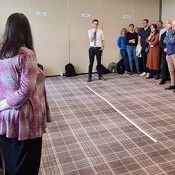Rebecca Hamer, Graham Hudson, Dean Seabrook & Stuart Shaw

At our first AEA Europe conference since the pandemic we hosted a ‘Discussion Group’, the topic of which was whether technology should drive and inform what we teach, learn and assess. It seemed a relevant question to ask given the recent seismic shift towards digital platforms. The pandemic showed us that when push comes to shove not only could effective vaccines be created in record time, educators and institutions could also migrate into the digital sphere in a speedy fashion.
The existing Cross the Line activity effectively visualizes different participant experiences. We proposed a variant, Crossing-the-line, formulating a small set of sufficiently provocative statements to ensure the group would divide itself into opposing positions. For our session most of the chairs were removed from the room while we laid two lines (with tape) on the floor. This led to some initial uncertainty when participants entered a nearly empty room.
We asked our participants to gather behind one of the two lines on the floor, leaving an empty “neutral zone” in the middle. After the activity was explained and the first statement was read, the group divided again with people assembling behind the line that reflected their standpoint. Graham and Dean invited our guests on opposites sides to clarify their arguments in favour (behind the white line) or against (behind the red line). We presented six different yet highly contentious statements in succession, two of which unexpectedly resulted in very extreme divisions, with only two or three participants on one side and the rest all on the other (see photo).
The room was full of activity and people having a bit of fun, The response to one of the statements showed that at least one may have reflected a degree of tunnel vision by the authors. Very reasonably, those not in favour of making “All high stakes assessments (…) digital” pointed out that you would not like your surgeon or fire fighter to only have practice in digital simulations.
At the end participants gave feedback on their experience, their main takeaway and any tips to improve the process on post-its.
In general, participants very much appreciated the active format. They liked that they could hear so many different opinions, that you could see how many shared or opposed a statement and that many had reasonable doubts about the digital future. While the statements were purposefully provocative, the absolutist nature made it sometimes difficult to be in favour of any of them. In addition, perhaps fewer statements would allow for more follow-up discussion.
A small sample of the take-away messages have been reproduced in photo 2. Comments included: academics “love to quibble” over wording: that nuance is important; and, that context and considerate choices help us see and “shape the learning opportunities”, without being “driven by the inevitable.” Importantly, that while much of research focuses on higher education, the issues that we run into are often the same in secondary and even primary education, and that if we listen to each other, “we have the power to influence the future.”

